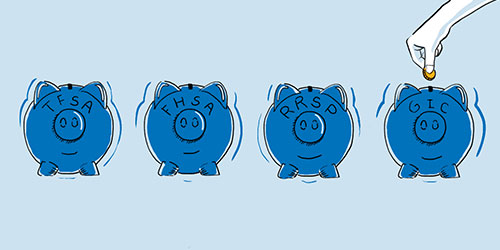As a newcomer, it's important to understand Canadian savings and investment products so you can achieve your financial goals. In this guide, we'll break down what accounts are available, explain differences, and provide advice on maximizing the growth of your savings. Let's get started!

Types of savings accounts in Canada
In Canada, there are many types of savings accounts available to you. Registered and non-registered savings accounts are the two main categories. Registered savings accounts are ones registered with the federal government, such as Registered Retirement Savings Plans (RRSPs), Tax-free Savings Accounts (TFSAs) and First Home Savings Accounts (FHSAs). They offer tax advantages and can help you save for specific purposes.
Non-registered savings accounts, like regular savings accounts or high-interest savings accounts, are not registered with the government. They provide flexibility but may not offer the same tax benefits. Guaranteed Investment Certificates (GICs) are also popular non-registered savings options.
How to choose the right savings account
To choose the right savings account, consider your long-term and short-term goals. Think about how accessible you need your funds to be and how much risk you're comfortable with.
Here are some pros and cons of each type of account:
RRSPs offer tax deductions and are ideal for saving for retirement. However, withdrawals are subject to taxes and certain restrictions. As a newcomer, you'll have to wait to contribute to an RRSP until you've reported your first year of income to the Canadian Revenue Agency (CRA). This is because the amount you're allowed to contribute is based on the income you earned in the previous year.
TFSAs provide flexibility and tax-free growth, meaning you don't pay tax on your earnings when you make a withdrawal. You can save for various purposes, including short-term goals or emergencies. A drawback is you can only contribute a limited amount per year. Unlike with RRSPs, you can save money in a TFSA during your first year in Canada if you meet CRA residency requirements.
FHSAs are designed to help you save for your first home and combine the benefits of both RRSPs and TFSAs. Your contributions are tax-deductible, and you don't pay tax when the time comes to withdraw, however, your annual contributions are limited. Like with TFSAs, you can start saving with a FHSA in your first year here.
GICs offer a guaranteed return on your investment and are low risk. However, they can have less withdrawal flexibility and lower interest rates compared to other accounts. You can purchase a GIC anytime as a newcomer.
Remember, everyone's financial situation is unique. When choosing a savings account, it's good to work with a financial advisor who can help evaluate the best option for you.
How to maximize growth of your savings
Aside from traditional savings accounts, you can explore market investment options to maximize the growth of your savings. Some accounts allow you to invest the money within them, which means your savings can participate in the stock market with products such as stocks, bonds, or mutual funds*.
Keep in mind that there may be fees associated with investing, including management fees and transaction costs. Take time to research and compare these fees when choosing your investment products.
Advice for making the right savings choices
To make the most of your savings, here are some helpful tips:
Prioritize your savings goals: determine what's most important to you in the short-term versus the long-term and allocate your savings accordingly. Whether it's buying a home, starting a business, or saving for retirement, having clear goals will guide your savings strategy.
Automate your savings: set up automatic transfers from your chequing account to your savings or investment account. This way, you won't forget, and your savings will benefit from compounding interest.
Diversify your portfolio: spread your investments across different types of assets, such as stocks, bonds, and mutual funds*. Diversification helps reduce risk and can potentially enhance your long-term returns.
Understand tax implications: when it comes to withdrawing funds from your investments, be aware of any tax consequences. Different accounts have different rules, so talk to a tax professional or financial advisor to understand how much you may owe if you cash out your savings.
Canada offers many savings and investment options to help you achieve your financial goals. Some may be similar to what you know from back home, and some might be new to you. To feel confident about your savings choices, talk to a Servus advisor who will offer personalized guidance so you can build a secure financial future in your new home!
And to learn more about banking services designed to help you on your journey, check out our Newcomer Banking Package.
*Mutual funds and other securities are offered through Aviso Wealth, a division of Aviso Financial Inc. Commissions, trailing commissions, management fees and expenses all may be associated with mutual fund investments. Please read the prospectus before investing. Unless otherwise stated, mutual fund securities and cash balances are not insured nor guaranteed, their values change frequently and past performance may not be repeated.

